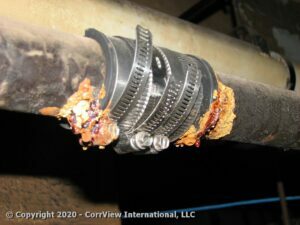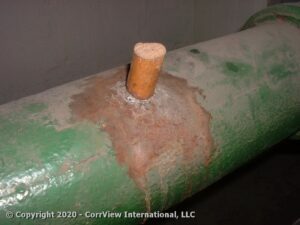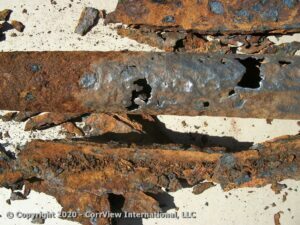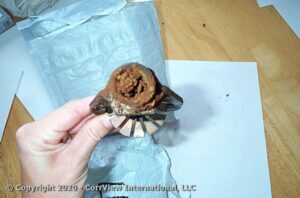Case History: CH-02
Three Strikes
| Proof That A Corrosion Threat Does Not Always Produce The Appropriate Response |
-
Preface
 A chemical water treatment company acquires a new contract for an older New York City building property known to have not been well maintained or chemically protected. Large rust and scale deposits are found in all strainers and have accumulated throughout the system based upon examples of pipe removed. Thread leaks are evident at some examples of pipe.
A chemical water treatment company acquires a new contract for an older New York City building property known to have not been well maintained or chemically protected. Large rust and scale deposits are found in all strainers and have accumulated throughout the system based upon examples of pipe removed. Thread leaks are evident at some examples of pipe.
A large duplex coarse basket strainer, when opened for spring clean-out, shows it almost fully clogged with heavy rust deposits, some larger than a silver dollar. The 14 in. condenser water system is fully drained for freeze protection every year, which helps to explain the large volume of rust deposits.
Prior to entering their agreement with the building owner, the water treatment representative suggests an ultrasonic investigation of the 50 year old condenser water system in order to learn of any threats potentially impacting their planned chemical cleaning and treatment program. Concern to a major failure occurring within the upcoming cooling season is also a major concern.
-
Investigation
The chemical treatment company recommends the services of CorrView International, LLC and a contract directly with the building owner is produced. Our investigation shows a moderate to high average corrosion rate of near 5-6 mils per year (MPY) and more severe pitting at the bottom of all horizontal lines likely due to the accumulation of heavy rust deposits. All pipe is heavily deteriorated due to the fact that it is fully drained every winter season – a condition documented to increase corrosion activity 5 or more times.
 A visual inspection of a section of exposed 14 in. condenser water pipe, cut open at the bottom by building engineers in order to attempt to remove large rust deposits interfering with water flow, shows approximately 3 in. of rust product at the bottom of the cooling tower supply and return headers. There is limited success at trying to flush out the deposits with a fire hose due to their weight.
A visual inspection of a section of exposed 14 in. condenser water pipe, cut open at the bottom by building engineers in order to attempt to remove large rust deposits interfering with water flow, shows approximately 3 in. of rust product at the bottom of the cooling tower supply and return headers. There is limited success at trying to flush out the deposits with a fire hose due to their weight.
Ultrasonic testing at examples of large 14 in. condenser water pipe at the lower floors show it near near 0.200 in.; down significantly from its original extra heavy specification of 0.500 in. With the roof level pipe at the cooling tower now reaching 0.100 in., it becomes clear that the larger main lines will soon require replacement. Still, this finding represents a significant length of trouble free service for a building operating under less than ideal water treatment and maintenance conditions.
Further testing at the individual A/C units served by the main riser produces far greater concern. Here, the 50 year old and originally schedule 80 threaded pipe has deteriorated to near or below minimum acceptable limits. All distribution lines are threaded, which for pipe at 3 in. and 4 in. diameter means an initial 0.105 in. thread cut loss. After 50 years of service, we identify a substantial number of pipe locations having a current wall thickness of near 0.140 in. or below, and dangerously close to the point where a total pipe separation might occur. With pressures of near 175 PSI at the lower floors, significantly greater threat is possible due to a 3 in. or 4 in. take-off line separating completely at its threads, in contrast to a pinhole leak at the main 14 in. roof level headers. Our recommendation is to immediately replace every section of threaded pipe prior to its first reliable isolation valve from the riser, then replace all threaded run-out piping, followed by larger scale planning to replace the main risers entirely. With a large scale project defined, we recommend beginning the replacement of the run-out piping at the lower floors due to their higher operating pressures.
The building owner questions the report and hires another ultrasonic testing service to check and verify our results. The UT company reviews the CorrView report addressing 75 examples of pipe and 924 wall thickness measurements taken throughout the entire building, and selects one area of 14 in. main condenser water pipe for further testing. They take 4 wall thickness measurements in the general area referenced by the CorrView report; covering approximately 4 ft. of a 16 in. cooling tower supply header. The company does not measure or identify the lowest 0.102 in. wall thickness documented in the CorrView report within their 4 thickness measurements taken, and consequently produces a scathing report to the building owner questioning the validity of the entire CorrView report. No further statistical analysis of the 4 wall thickness measurements is produced, with only a listing of the 4 wall thickness measurements submitted. Results state that wall thickness measurements produced in the CorrView report could not be verified, and that the entire report should be discounted as in error.
The building owner submits this critical review to the chemical water treatment company in criticism to their recommendation of CorrView International, LLC, with the letter then forwarded to our office for comment.
We return to the subject property and to the area in question. Within approximately 30-40 measurements and approximately 10 minutes of investigation we again locate the 0.102 in. low wall thickness documented in our original report. Further scanning, now approximately 6 months after testing had been first performed, identifies even lower wall thickness measurements of 0.095 in. at this 14 in. condenser water pipe. The very specific areas containing the 0.102 in. and 0.095 in. wall thickness measurements are circled and clearly marked with their dimensions using spray paint. Photographs are taken of the pipe location and its measurements.
A follow-up report is then submitted to the property owner and chemical treatment company documenting the confirmation of our prior findings, as well as even lower wall thickness measurements now 6 months after the first measurements were taken. We again state that a failure of the main risers due to pitting will likely be in the form of a small pinhole, whereas failure at the 3 in. and 4 in. threaded run-out pipe to the units is likely to be a total catastrophic thread separation, and occur at a lower floor riser operating under higher pressures.
The building owner submits the original CorrView report, the critical review by the other UT contractor, and our follow-up letter to a well known and respected independent 3rd party water treatment consultant for review and recommendations. The consultant, (as CorrView would surprisingly learn many years later while working together at a building property in Dallas), raises serious concern for the New York City building owner and reiterates prior CorrView recommendations to immediately replace all threaded pipe as the minimum action required. The consultant emphatically warns to the potential of a catastrophic failure of the condenser water system.
The building owner discounts the recommendation of the water treatment consultant, and follows the recommendation of a 1 page report based upon 4 wall thickness measurements over CorrView’s 186 page report covering 75 sets of data, and follow-up rebuttal firmly documenting the error by the second ultrasonic testing firm. The building takes no actions to repair the piping.
-
Conclusion
Approximately 8 months from the date of our original report, on a Sunday night at near 2:45 AM, a 4 in. threaded nipple at the main riser completely separates at the riser threadolet. The release drains the entire cooling tower system through 7 floors of tenant space comprising computer rooms, a small data center, and library storage space on its way to the lobby. The building’s Chief Engineer, at home and sleeping at 3AM, is alerted to the failure through a low cooling tower water alarm to his cell phone.
By the time the make-up water is shut down and the 14 in. risers drain 26 floors down to the 7th floor, approximately 6 in. of water has filled the lobby and is cascading out the front doors and down the stairs. The failed 4 in. pipe nipple is later shown to be one which had been ultrasonically tested by CorrView at Location No. X, and specifically identified in need of immediate replacement 8 months prior. Damage estimates exceed $900,000, with final damages and lawsuit claims unknown.
The chemical water treatment company had not taken the contract based upon CorrView’s findings, and is especially grateful to not be ensnared into the legal damages claims which follow.
© Copyright 2023 – William P. Duncan, CorrView International, LLC




















